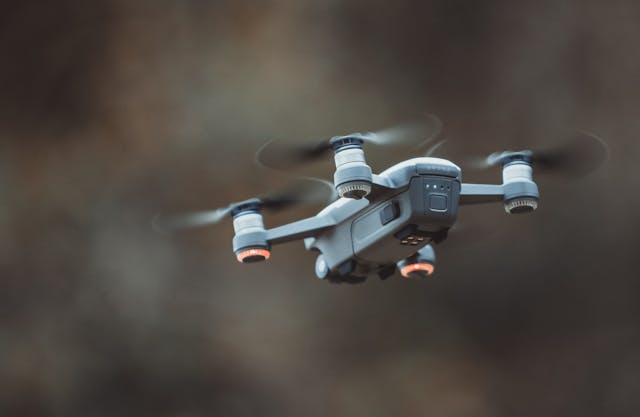
How do drones hover? Drones hover by using a mix of sensors to adjust their rotor blades.
The majority of commercially available drones have four sets of rotor blades, one on each corner. This makes them much easier to control at low speeds and much more stable. The military have drones like this, but they also have remote control planes. They are all drones, but the remote-controlled planes have to keep their speed up or they will stall and fall out of the sky. Drones with four sets of propellers have the ability to balance because all of the rotor blades act to counter the motion of the other blades. From now on, whenever I use the word “drone”, I’m talking about one of the commercial drones with a propeller on each corner.
A rotor producing lift is an example of Newton’s third law of motion, “for every action, there is an equal and opposite reaction.” In this case, the rotor spins and pushes air down. The downwards force produces an equal and opposite reaction, which is lift. The helicopter goes up. The problem with a rotor blade is that it spins and the helicopter naturally wants to spin in the same direction as the propeller. To stop that, helicopters have a tail rotor, which spins and produces a force to counter the spin of the rotor blades. Drones with four propellers can counteract this spin by having the propellers spin in opposite directions. For example, if the propeller on the front left spins clockwise, the drone will want to turn clockwise. The propeller on the top right is set to spin anticlockwise to counteract this force and keep the drone straight. The drone can also use this opposite spin to move. By slowing down the propellers on one side of the drone, the lateral force is increased and the drone will move either left or right.
So, how do drones hover? They have several systems that they can use and a lot of those systems are similar to the things we have in our phones. The drone uses cameras, accelerometers, gyroscopes, GPS, and often a gimbal on the camera. The drone uses the camera at low levels to keep a visual track of the ground. This is a basic sensor and only works if the drone is close enough to the ground. The main things that keep a drone hovering are the accelerometer and gyroscope. If the drone moves in any direction, the body of the drone will move in that direction. The accelerometer will detect the movement and it will know how quickly the drone is moving. The gyroscope will detect the angle that the drone is moving at. The wheel of the gyroscope is spun by a motor and when the drone moves, the forces on the wheel change depending on which way the drone is moving. Sensors can detect these forces and work out which angle the drone is tilting at. The drone also has an onboard GPS so that it knows where it is and it has a magnetometer to help it follow the Earth’s magnetic field.
All of these systems feed information to the onboard computer, which is the brain of the drone. It uses the information it receives to make micro adjustments to the propellers to stay stationary, in the same way your brain takes information from your ears and eyes to make micro adjustments to your muscles and stay standing up. All of this work is done by the drones PID controller. PID stands for Proportional, Integral, Derivative. The PID controller works by using corrections to keep the drone as close to a desired point as possible. If we want the drone to hover horizontally in the same place, then the PID setpoint if for zero degrees of movement and zero cm of movement. The PID controller is fed information from the accelerometer and the gyroscope, which tell it if it is moving away from its setpoint. The PID controller then sends power to any of the four propellers to get it back to its setpoint. These adjustments are very small and very fast, keeping the drone in the same place. They are so effective that drones can hover in strong winds as well. Although, generally, the more expensive the drone, the better and the longer it can hover. Many drones will also have a camera that is on a gimbal as well, so even if the drone does move slightly, the video will stay perfectly still. And this is what I learned today.
Sources
https://www.autelpilot.com/blogs/news/hovering-drones-what-should-i-do
https://docs.duckietown.com/ente/course-intro-to-drones/pid-controllers/theory/pid-generalities.html
Photo by Pok Rie: https://www.pexels.com/photo/grey-quadcopter-drone-724921/
